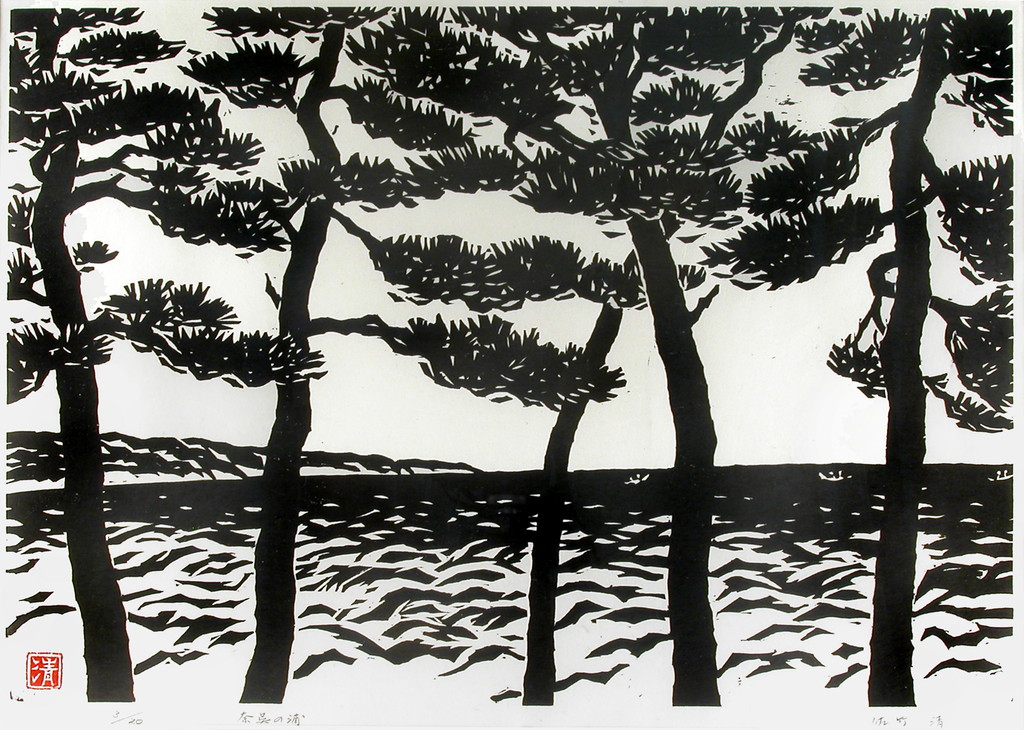歌碑19「奈呉の海」-伏木一の宮バス停Monument No.19 “The Sea of Nago” -Fushiki Ichinomiya Bus Stop
2022年07月13日

奈呉の海は現在の高岡市から射水市にかけての海で、その海は国守館からも見えたのかもしれない。(版画 : 佐竹清「奈呉の浦」高岡市万葉歴史館蔵)
The Nago Sea stretches from present-day Takaoka City to Shinminato City. The sea was likely visible from the Kokushukan (the government headquarters). (Print : Kiyoshi SATAKE "Nago no ura", Takaoka Manyo Historical Museum collection)
![万葉歌めぐりの旅[Man'yōshū Literary Pilgrimage]](https://www.manreki.com/manyo-songs/images/common/pic_logo.svg)












解説
Commentary
奈呉の海
The Sea of Nago
『万葉集』の4032番の歌。『万葉集』は、7世紀前半から8世紀後半にかけての約130年間の歌を収めた現存日本最古の歌集で、4500首余りの歌が収められている。この歌の作者は田辺福麻呂(たなべのさきまろ、生没年不詳)。
巻十八の巻頭歌群。田辺福麻呂は題詞に「左大臣橘家の使者」と記される通り、橘諸兄から派遣された使者である。橘諸兄は家持にとって政治的に重要な後ろ盾であり、その使者である福麻呂の歌を巻頭に並べたのも、そうした背景と無関係ではないのだろう。
奈呉の海は現在の高岡市から射水市にかけての海で、その海は国守館からも見えたのかもしれない。あるいはそうでなくとも、波の音は届いていたことだろう。海のない大和(奈良)からこの地を訪れた福麻呂にとって、そうした館からの海の風景は珍しく感じられたはずである。ここではそれを舟で見てこよう、と自身の海への関心を誇張して表明することで、歓迎の宴に相応しい挨拶の歌としている。高岡市の伏木一宮バス停に歌碑が立つ。
(解説 ピーター・J・マクミラン)
This is poem number 4032 of the Man’yōshū, the oldest existing collection of poetry in Japan. The Man’yōshū consists of over 4,500 poems and was compiled over a period of around 130 years, from the first part of the 7th century to the latter part of the 8th century. The author of this poem is Tanabe no Sakimaro.
The Nago Sea stretches from present-day Takaoka City to Shinminato City. The sea was likely visible from the Kokushukan (the government headquarters), and at the very least the sound of the waves could be heard from there. The view of the sea from the Kokushukan must have been a rare sight for Sakimaro, who came from land-locked Yamato. Sakimaro’s charming poem was perfectly appropriate for its intended role as a banquet greeting, expressing a playful desire to go out in a rowboat on the unknown sea.
This poem is one of the first poems in Book 18 of the Man’yōshū. As the author writes in the heading, he is the emissary of the Minister of the Left’s Tachibana family and was dispatched by Tachibana no Moroe. Tachibana no Moroe was an important political supporter of Yakamochi, and the likely reason for Sakimaro’s poem being included at the beginning of the book.
This waka poem stone monument stands in front of the Fushiki Ichinomiya bus stop in Takaoka City.
(English Translation and Commentary by Peter Macmillan)